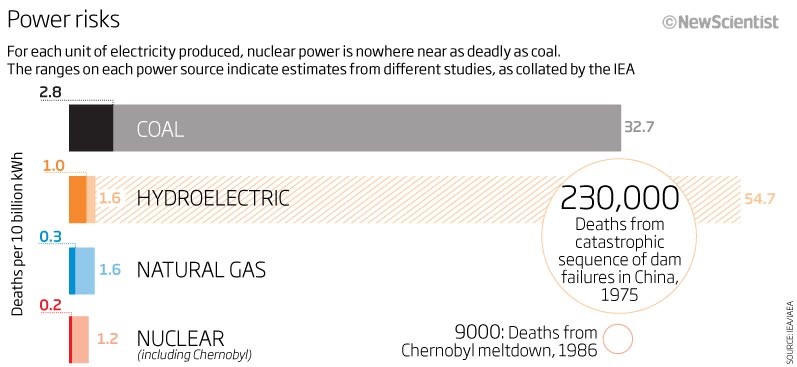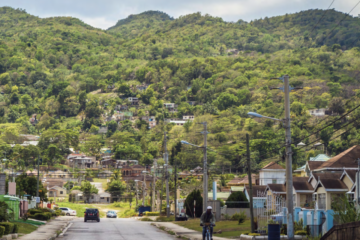It has been 10 years since the Oscar-winning documentary An Inconvenient Truth was released which spread the scientific consensus on human-caused global warming. However, whilst the average citizen may have been new to this, the scientific evidence for effects of increased emissions of greenhouse gases like carbon dioxide in increasing global temperatures have been conclusive since the 1950s. Whilst the documentary did a great service in increasing the awareness of the necessary policies to mitigate the risks, surprisingly a few factors in the solutions were ignored – namely, the role that nuclear energy can play in the fight against climate change.
Whilst recent years have witnessed massive improvements in the efficiency and affordability of renewable energy, namely solar and wind, in the last decade, the efficiency of photovoltaic panels has increased by 25% and price per unit kilowatt hour have fallen by 60%. However even with such advances and ever-improving batteries, the grim reality is that for prolonged periods when the sun is not shining or the wind is not blowing, no energy is produced. Therefore we can never replace fossil fuels with renewables for power-hungry nations as they provide the essential basic load. The low carbon alternative for basic load is nuclear.
For reasons other than science, climate change activists have had an evangelical aversion to nuclear power. Until nuclear fusion becomes a commercial reality, humanity must make its peace with nuclear fission. Nuclear produces 12 grams of CO2 per kWh, which is roughly the same for wind. Nuclear is therefore a very low carbon alternative. Whereas the intermittency for solar means that even the newest panels run less than 30% of the time, the average nuclear plant runs 94% of the time. According to estimates by Dr James Hansen, a pioneering climate scientist from NASA, the land footprint required to power the world on only wind, solar and biofuels would require a space greater than Australia, which he comically refers to as “Renewistan”. Clearly not a viable solution. Furthermore, excluding the great orange menace in 1600 Pennsylvania Avenue, there has been a global kumbaya moment in solidarity with the Paris Climate agreement. However, because of an overreaction to the 2011 Fukushima disaster, Germany and Japan have prematurely decommissioned nuclear power plants and replaced them with cheaper coal, gas and oil burning plants, moves which have actually caused increases in their emissions: both are set to miss their 2020 emission targets. The reality in developed nations is that there has been a fall in the percentage of non-carbon based fuels. This is an alarming statistic.

What’s more: since 1995, the world has seen a reduction in the percentage of non-fossil fuel energy due to the steady decommissioning of old nuclear and hydroelectric plants and the reluctance to build new ones, as well as the growth in energy demand from the developing world. And if present trends hold, the world will lose four times more nuclear power over the next decade than the last decade.
Over the next 30 years, global CO2 emissions will actually increase by over 850 gigatons, even with the Paris climate agreement. Paris was not a be-all-end-all agreement, but the first step. The Earth is losing its battle and we must be on our Road to Damascus today. But to some in the environmentalist movement, even coal is better than nuclear. Much of the fear behind nuclear fission is threefold: nuclear waste, nuclear meltdowns and nuclear proliferation.
Only thing to fear is fear itself
All but four nations are within the purview of the Nuclear Non-Proliferation Treaty (NPT), so the fear that the use of nuclear energy would open a Pandora’s Box of nuclear weapons is far-fetched. The chain reaction from a proton addition to uranium-238 produces an end-result of plutonium-239, which is one of the three usable fuels for nuclear weapons. However, whilst the science shows a clear link between using the spent fuel from nuclear power plants and their further use in weapons – what is not shown is the absence of political will. Violations of the NPT attract sanctions and economic ruin, thus nations varying from South Africa and Ukraine to Iran and Libya have all voluntarily given up their weapons. There are 31 countries with active nuclear power plants and only 8 with nuclear weapons, hardly an indictment on the link between energy and proliferation. On the contrary, as seen in Russia and America, as their vast Cold War stockpiles have been decommissioned, the plutonium in the warheads have been recycled into fuel rods for smaller power plants.
The fear of radioactive waste is legitimate – if and only if taken in a vacuum. If all the energy used in the lifetime of a single American came from nuclear, the end waste would be the size of a coke can. In fact, all of the UK’s radioactive nuclear waste (spent fuel rods) can fit inside an Olympic swimming pool. However, had coal been used, the total waste would exceed 19,000 tons of CO2; the fallacy lies in the inability of anti-nuclear activists to acknowledge the opportunity cost. In fact, just three grams of uranium can release (via fission) ten times more energy than one ton of coal. Furthermore, since being abandoned in the 1960s, fast-breeder reactors have ignited the interest of scientists once again. Fast-breeder reactors reduce fuel requirements by a factor of 100 compared to widely used light water reactors. The fact that plutonium-239 has a half-life of 24,000, thus requiring to be stored for 250,000 years before the radioactivity is safe, is a dangerous thought. Creating the necessary infrastructure which would need to last longer than homo-sapiens have been in existence is no easy feat.
However, as Franklin Roosevelt reminded us: the only thing we have to fear is fear itself. This fear of nuclear is soon becoming a relic of the 20th century with the advent of nuclear reprocessing. At present, in each uranium spent fuel rod, only 4% are fission waste products. The remaining is 95% uranium and 1% transuranic elements. Nuclear reprocessing enables the recycling of the usable 96% by separating the 4% waste by means of pyro-processing to reproduce new fuel rods. As a result, the final end waste is reduced in volume as well as radioactivity – requiring to be stored in repositories for a more manageable 500 years (here’s an introductory video to nuclear recycling for those interested).
Chernobyl and Fukushima have contributed to trust deficit on the safety of power plants against meltdowns, yet what is little known by the public is that fossil fuels have killed far more than nuclear accidents. In a report published by the 2002 IEA (before Fukushima), it found that nuclear had the lowest death toll for the four major sources of electricity. Furthermore, incidents like Chernobyl and Fukushima could have been avoided had better judgment prevailed. In the case of Chernobyl, there was a totalitarian regime incapable of handling dissent. The plant engineers were afraid to report early defects and were pressurized to activate the reactors to dangerous levels. Had a more transparent and healthy atmosphere been fostered, the USSR would not have had the ignominy it got. And in the case of Fukushima, its hardly wise to build a nuclear power plant on an active earthquake fault line.
Our greatest Faustian bargain
In democracies, elections have consequences. In all the damage done by Richard Nixon, one of the least publicized is his enslavement to the military industrial complex in scuttling research on nuclear reactors without the risks of meltdowns. The designer of the widely used light water reactor, Alvin Weinberg, had designed a second model, one which he preferred and successfully built which proved to be a far superior alternative for civilian use. A molten salt thorium reactor would operate at low pressures unlike the high pressures required in light water plants, thus removing the scope for human or ever machine error, in preventing accidents. Thorium reactors have the potential to produce 90 times more energy than uranium with a fraction of the waste. But Weinberg was fired by the Nixon administration because of his advocacy for his safer alternative reactor, a decision which effectively stopped its development.

Yet JFK’s warning of “the instrument of war far outpacing the instruments of peace” could not be more fitting for his rival in the election of 1960. Thorium molten salt reactors’ inability to produce fissile weapons-grade waste products (unlike in uranium which produces plutonium in the decay process) could not be forgiven by Nixon. So is it any wonder that Weinberg would later call nuclear energy societies’ greatest “Faustian bargain”? Only recently, and that too in India and China, have the thorium molten salt reactor received fresh funds for research, but there has a been a criminal 40-year delay.
In 1945, Dr Oppenheimer, after the successful nuclear tests at Trinity quoted “I have become death, the destroyer of worlds” – from the Hindu Gita – heralding the nuclear age. Since WW2, the world has lived under the spectre of nuclear war, with former Soviet Premier Mikhail Gorbachev claiming now more so than ever. In the past, be it the USSR and America or even India and Pakistan, there was at least the basic sanity and understanding of mutually assured destruction. Today, we are facing a madman with a nuclear arsenal capable of destroying the planet a thousand times over – and we also have Kim Jong Un. Yet when scientists discovered the power behind splitting the atom, from Rutherford to Otto Hahn, their pursuits were for the expansion of human knowledge. Their pursuit, and their spirit, may be the salvation to Climate Change.

